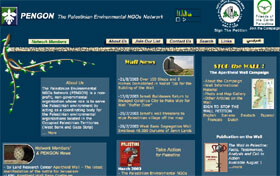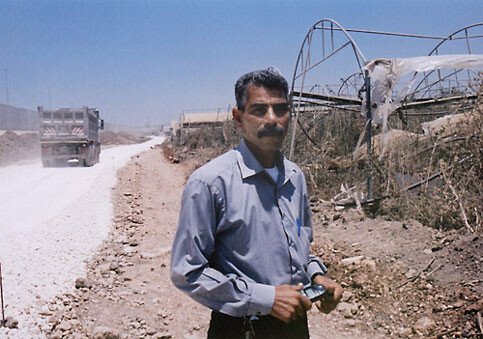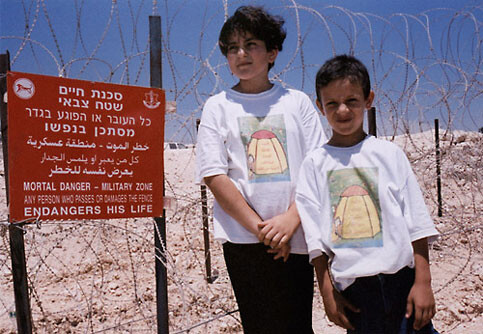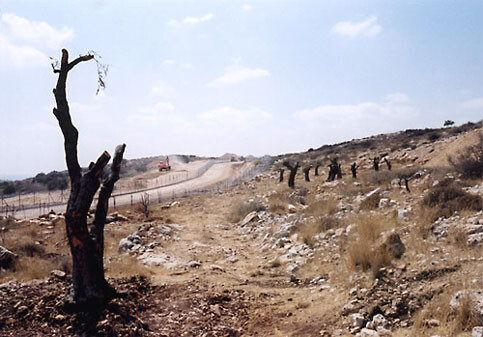
PENGON’s website, click to visit. (EI)
Forget the fact that I was in the West Bank during a cease-fire, for the “ceasefire” had a technical meaning only. It meant simply that there would be no horrific bus bombs in Israel. All the rest continued unabated. Firefights between the IDF and Palestinian fighters carried on. Several Israeli civilians were killed and injured. Israel continued to murder and illegally detain civilians, destroy homes, issue demolition orders, close communities, stifle transportation, and construct a massive wall around the entire West Bank. Thanks to Jamal Juma’s contacts, I completed a tour of this wall in July and August. The facts are grim: 650 km of massive concrete slabs, trenches and electric fences, images which make the Berlin Wall look like a white picket fence.
The personal testimony is worse. Fayez Altanib of Irtah village near Tulkarm broke down in tears as he showed me his ruined greenhouses next to the wall. Three times he repaired his severed irrigation lines and three times the IDF cut them. His family and the families of his eight employees are now without income.

Fayez Altanib stands before his destroyed greenhouses next to the wall near Irtah. (Darren Ell)
“Where is the peace?” shouted Jamal Othman over and over as he looked out at the massive scar on the land created by the wall north of Tulkarm where his olive groves once stood. “Where is the peace?” he shouted, as he showed me the view from every one of the windows of his home: trenches, electric fences and signs warning of the “mortal danger” to those approaching the fence. The loss was enormous: 350 dunams (87.5 acres) of land, 3,000 olive and almond trees, and this year’s harvest whose value he estimated at over US $350,000. Also lost were any future harvests, and the financial security of the 130 people from 22 families who depended on the sale of the land’s produce. Lost as well were four generations of family history linked to the land. All that remained were a few hundred healthy trees and a field of sawed-off olive trees, a parting gift from the Israeli contractors building the wall, a mistake apparently.

Jamal Othman’s children, Jamal and Yazid, stand next to the wall located 25 meters behind their home in Jerushiyye. (Darren Ell)
Basim Yusef Wakid of Jayous village showed me what remained of his once lucrative olive groves. Amid the few dozen healthy trees was an eerie landscape of bulldozed land with ancient sawed-off olive trees, a gift from the Israeli army. His family and the family of his five brothers are now without income.

Bassim Wakid behind his home in Joyous. (Darren Ell)
As usual, I photographed quickly, aware that the army had their binoculars trained on us from across the ravine where the wall was being erected. “No one comes to visit anymore. They’re all afraid. The soldiers have been shooting at our homes,” he said. He took me around the back of his home, showing me the bullet holes. “We can’t come out of our home at night because they park their jeeps in our front yard. They even tell my children this is not their home anymore.”
Jamal Hassounah, the mayor of Zeita, told how his village had been reduced to a refugee camp in one year. 30% of the villagers’ land had been destroyed by the wall construction and most marketing possibilities in Israel had vaporized. Their remaining land was on the Israeli side of the wall. In late August, the agricultural gate leading to the land was closed for four days, and only subsequently opened after the Red Cross pleaded with the Israeli army to open it. Without this gate, farmers must travel 10 km to access their lands, which are only a few hundred meters from the village. The economic shock was registering as 500 families had begun turning to the Palestinian Authority and the World Food Program for support.
I heard the same story in Qaffin, where the mayor, Taisir Harashi, recounted his village’s history. 70% of Qaffin’s land was lost to Israel in 1948. In the last year, 60% of what remained had either been crushed by the wall or simply annexed to the other side. 10,000 olive trees had been uprooted, and another 120,000 had been lost to Israel on the other side of the wall. The inhabitants, who before 2000 worked in Israel, now have virtually no income. Another new refugee camp.
In Beit Sahour, south of Jerusalem, the stories were the same. Ten year old Dia’ Zawahra posed for me outside his home where an electric fence surrounded it on 3 sides at a distance of 2 metres in places. His nightmares had stopped even though his family had recently heard that a demolition order might soon be issued.
Israel’s leaders call this a “security” wall, an entirely believable notion for a Western public massaged by images of the ravages of bus bombs but spared exposure to the daily violence and humiliation to which Palestinians have been subjected for over half a century. Little matter that “security” is the oldest line in the book used by oppressive states. It has been used to justify virtually every form of oppression and illegal invasion throughout history. Even the most brainwashed of hawks could not effectively argue that all this “security” has created a more secure world.
People, such as the Palestinians who live through the reality, see through this lie with great ease. Israel’s message to them is clear: “You are not welcome here. Get out.” Abdullatif Khaled, a hydrologist working with PENGON in Jayous village, showed me the projected path of the Wall. Conveniently, the path will cut hundreds of thousands of Palestinians off from fertile farmland and groundwater wells. He pointed out how an important objective of the wall is to sever the ancient Palestinian link to their land. “Once this is achieved, people will have fewer emotional connections to their land, and since their prospects will have been forever ruined, they will leave. This is the second phase of the “transfer” project in Zionist thinking.”
Being present on the ground and witnessing the violence and daily humiliations Palestinians endure, talking with people who have lost their homes and land without compensation, studying the details of the projected Wall as it cuts them off from their water wells and their most fertile land, watching as Israel cages them into a small fraction of the land they inhabited prior to 1948, Abdullatif’s remarks seem very apt. I think angrily of our high-paid journalists who continue to prattle government spin, who rarely if ever speak with the people I have met, who are incapable of putting together the blatantly obvious historical evidence, who cannot see this unfolding catastrophe for an entire people. That in the name of “security” Israel is allowed to enclose a largely defenseless people in the world’s largest open air prison from where its impoverished inhabitants can buy back their stolen water from Israel and run from passing Apache helicopters has got to be one of the century’s greatest scandals. As always, the outcome of this conflict will depend on the combined efforts of Palestinians and international civil society.

What remain of Bassim Wakid’s olive groves. Behind, construction on the wall continues. (Darren Ell)
Darren Ell is a photographer based in Montreal. He can be reached at f90xrudy@hotmail.com



